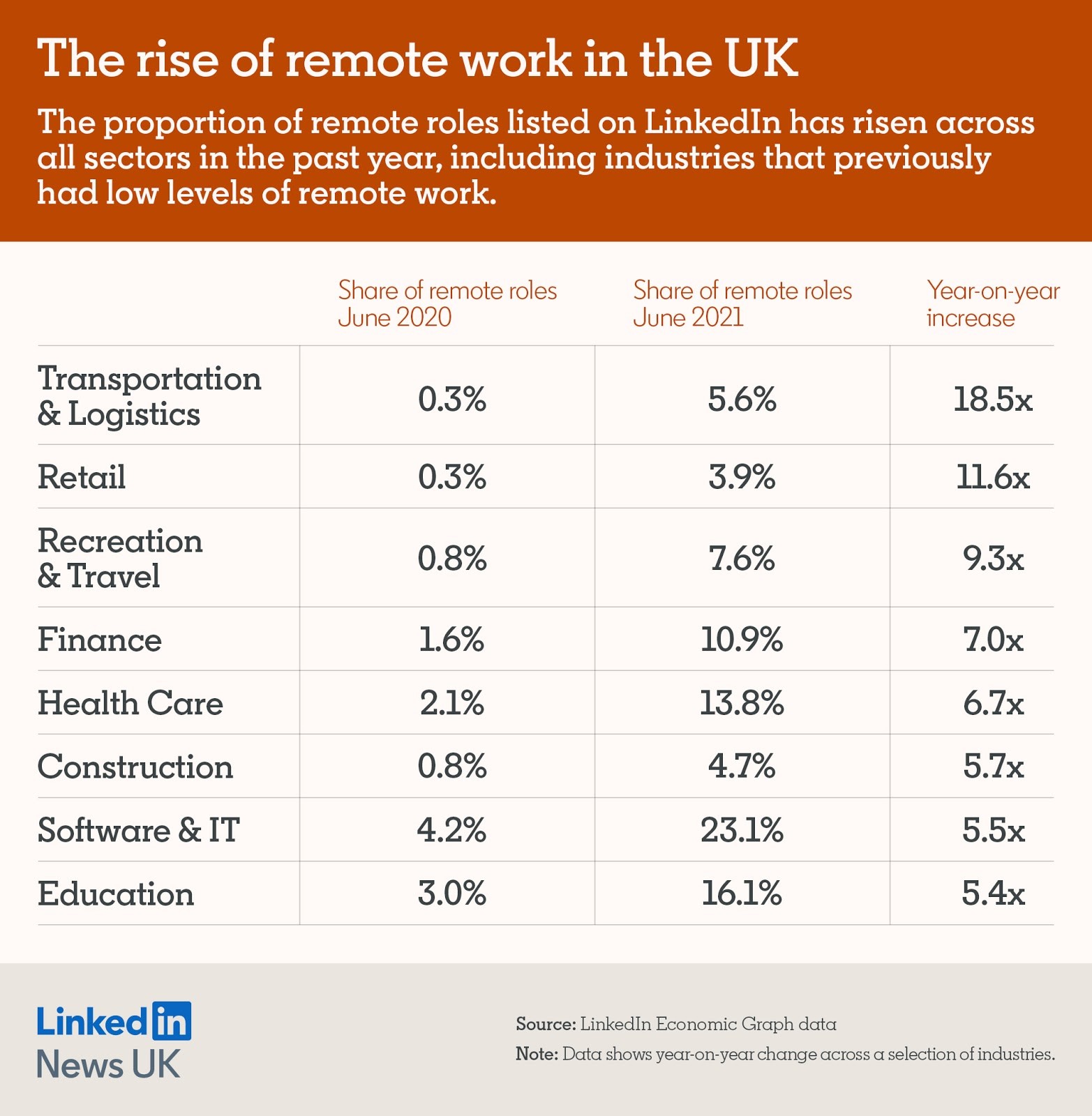- LinkedIn data finds remote job are on the rise despite offices reopening
- The share of remote jobs by industry ranges from 5 to 19 times the levels seen in June 2020 as the nation embraces greater flexibility
- Industries that had low levels of remote jobs one year ago, such as Retail and Transportation & Logistics, experienced double-digit increases of 11.6X and 18.5X respectively
- LinkedIn research finds that 38% of UK workers would prefer to work remotely full-time, while 49% prefer hybrid working, and 12% want to work full-time from the office
Despite the end of restrictions and the widespread return to the office in sight, remote job opportunities are still on the rise according to new data from LinkedIn, the world’s largest professional network.
LinkedIn’s UK Workforce Report shows that the share of remote job postings advertised on the platform has increased substantially across all industries, with some sectors recording 5 to 19 times the level of remote work postings compared to June 2020.
Additional research from LinkedIn finds that 38% of UK workers would prefer to work remotely full-time in the future, while 49% prefer hybrid working, and 12% want to work full-time from the office.
Adam Hawkins, Head of Search and Staffing at LinkedIn, said: “Remote roles are booming as companies consider new ways of working and the future of their physical office space. Many people have had a taste of the flexibility that remote working offers and now it has become a top consideration as candidates assess prospective employers. Companies offering remote roles will have their pick of the best talent, and we’ll see more businesses adapt their workplace policies to ensure the competitiveness of their employer brand. Recruiters will need to listen carefully to job seekers to find roles that match their needs, and advise companies on the new talent pools that will inevitably emerge as the traditional interdependencies between location and role are no longer as relevant.”
Industries that already had a relatively higher share of remote jobs in June 2020, such as Software & IT and Corporate, continue to invest in remote positions, seeing an increase ranging from 5.5X to 6.5X. The Software & IT sector in particular appears to be embracing remote work long-term, with more than one in five jobs advertised in June as remote positions. For industries like Healthcare, Finance, Hardware & Networking and Legal, now one in ten advertised positions in June were for remote posts.
Significantly, the trend for remote work has also transformed industries where remote work was previously thought to be impossible to adopt. Sectors with low levels of remote jobs one year ago, such as Retail and Transportation & Logistics, experienced double-digit increases of 11.6X and 18.5X respectively as the pandemic forced businesses to adapt. Though it is still possible some remote jobs may revert back to in-person roles in the future as firms adjust long-term.
Methodology:
LinkedIn analysed paid job postings open in June 2020 and June 2021 in the UK. A “remote job” is defined as one where either the job poster explicitly labeled it as “remote” or if the job contained keywords like “work from home” in the listing.
An additional study of 2,014 professionals in the UK was also referenced which was conducted by Censuswide for LinkedIn on 16th June 2021 to understand where people want to work in the future. Censuswide abide by and employ members of the Market Research Society which is based on the ESOMAR principles.
About LinkedIn:
LinkedIn connects the world’s professionals to make them more productive and successful and transforms the way companies hire, learn, market, and sell. Our vision is to create economic opportunity for every member of the global workforce through the ongoing development of the world’s first Economic Graph. LinkedIn has 756 million members and has offices around the globe. www.linkedin.com / mobile.linkedin.com






